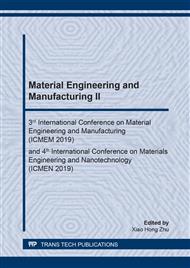p.104
p.110
p.116
p.121
p.133
p.139
p.145
p.151
p.156
Investigation of Cutting Performance for NAK80 Hardened Steel under Different Assisted Machining Systems
Abstract:
In this study, five different assisted techniques, including without assistance, laser-assisted, flood assisted, MQL-assisted and cold air-assisted were employed for NAK80 mold steel milling. The 18 set experiments were performed in each assisted system but 27 sets were executed in the without assistance situation. Under each assisted milling circumstance, the effects of process parameters on the variations of surface roughness, cutting force, tool wear and surface morphology of the workpiece are thus investigated. Milling experiments of NAK80 mold steel by cutting-tool of extra-fine particle tungsten carbide with TiSiN coating were conducted. And the experiments of the process parameter combinations such as spindle speed, feed rate and radial depth of cut were also planned. The results show that, under the same milling conditions, the surface roughness and cutting force are decreased as the spindle speed is increased, but both of them is increased as the feed rate and radial cutting depth are increased. In addition, the maximum flank wear of the cutting-tool is increased as the spindle speed, feed rate and radial cutting depth are increased. In terms of cutting assistance, the cutting performance exhibited in the cold air-assisted milling prevails over that in milling without assistance as well as with the other each assisted system. As a result, the cutting-tool flank wear, surface roughness and cutting force are all better than the other assisted techniques.
Info:
Periodical:
Pages:
133-138
Citation:
Online since:
January 2020
Authors:
Keywords:
Price:
Сopyright:
© 2020 Trans Tech Publications Ltd. All Rights Reserved
Share:
Citation:


